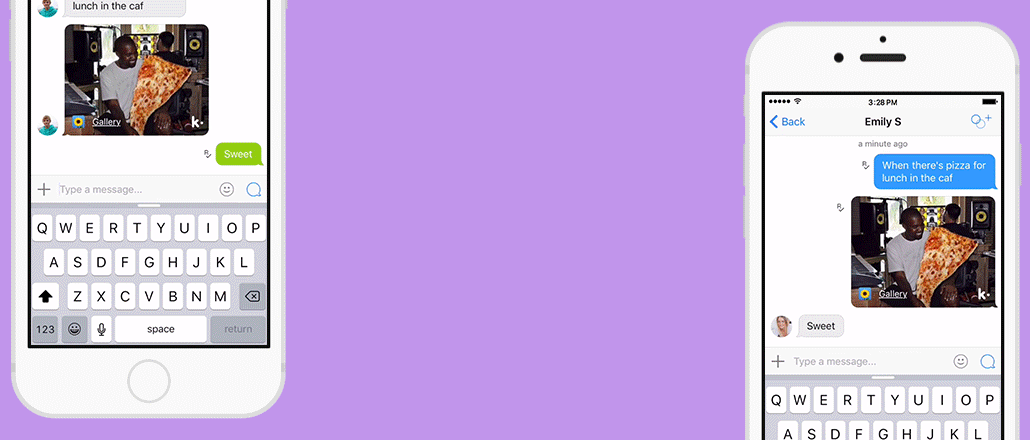
The messaging app Kik launched a keyboard today that combines emojis and GIF technology, opening yet another avenue for brands to get their content in front of a younger crowd that doesn’t tend to sit through commercials.
The new keyboard, through a partnership with a startup called Riffsy, lets users tap on an emoji to open a corresponding selection of GIFs related to the sentiment they wish to convey. There are a variety of GIFs available, some of them are from entertainment brands, though at launch there are no sponsored GIFs, but they are likely to come.
Riffsy partners with platforms like Kik, Facebook Messenger and even business-oriented LinkedIn to license its GIF-filled keyboard. People are generating tens of billions of GIF views a month through Riffsy, according to Riffsy CEO David McIntosh.
Kik, based in Canada, has been able to thrive in a highly competitive space, facing off with Snapchat, Facebook Messenger, Viber, Line, WhatsApp and others. The platform claims to have 240 million registered users but does not break down how many are daily users.
The most active Kik users, however, are prolific with their messaging — the average Kik session lasts 35 minutes, according to stats cited by the company. Also, half the users send emojis every day. The GIF keyboard uses emojis, and people tap the smiley face, winky face, thumbs up and other reactions to open a selection of GIFs that correspond to the sentiment.
“They make sure the greatest hits are there but also make sure fresh stuff comes in,” said Joe Rideout, Kik’s product manager.
For instance, with snippets of Drake’s “Hotline Bling” video being shared and turned into memes everywhere, Riffsy offers the clips in GIF form through its messaging partners.
Riffsy already has deals with movie studios and other entertainment brands, who offer their content free in exchange for the exposure, according to McIntosh. The next big deal is with “Hunger Games: Mockingjay Part 2.” Rideout said he could also envision working with, say, sports teams to make the clips featuring their players available when people go to share the GIF-mojis.
The marketing world is intrigued by messaging, lured to it as the platforms build new space for the brands to participate. Kik has led the way with sponsored chats controlled by bots that respond to consumers’ texts in a storytelling way. Facebook Messenger supported an automated chat in honor of the “Back to the Future” anniversary last month.
Brands are coming up with new ways for messaging users to text with them through the platforms for customer service. For instance, hotels like Hyatt now use Facebook Messenger as a kind of digital concierge.
The attention to messaging appears well placed: This year, the number of people using a messaging service will grow by more than 30 percent to 1.4 billion, according to eMarketer. Kik claims that “40 percent of U.S. youth” use the app.
Last week, the wonder-app Snapchat launched a store to sell animated filters called lenses, which people can superimpose on their selfies. Advertisers are creating Sponsored Lenses to get in on it. Tumblr began rolling out its own messaging tool just last week. Today, Facebook Messenger followed rival apps to introduce the first paid stickers for users to buy. The stickers are offered through another startup called PicoCandy, which works with other messaging apps like Viber to offer branded stickers from companies like McDonald’s.
The advertisers are just looking to get their message out any way they can at a time when younger people basically stopped watching TV commercials. Meanwhile, the movie “Minions” generated 100 million views through GIFs shared on messaging platforms, Riffsy CEO McIntosh said.
“You can take GIFs and put them in a wide variety circumstances, and they’re part of a language that people want to share,” McIntosh said. “Plus, all this traffic is on mobile.”
More in Media

The biggest SEO lessons in 2025 for publishers
KPIs are changing, more AI search data is becoming available, and publishers are looking beyond search to grow their audiences and revenue.

Digiday’s comprehensive guide to what’s in and out for publishers in 2026
Adaptability stopped being a nice-to-have for publishers years ago; it became a survival skill. Here’s a look at Digiday’s guide to what’s in and out for 2026.

Here are the biggest moments in AI for publishers in 2025
Here are some of the moments that defined how publishers adapted to the AI era this year.





